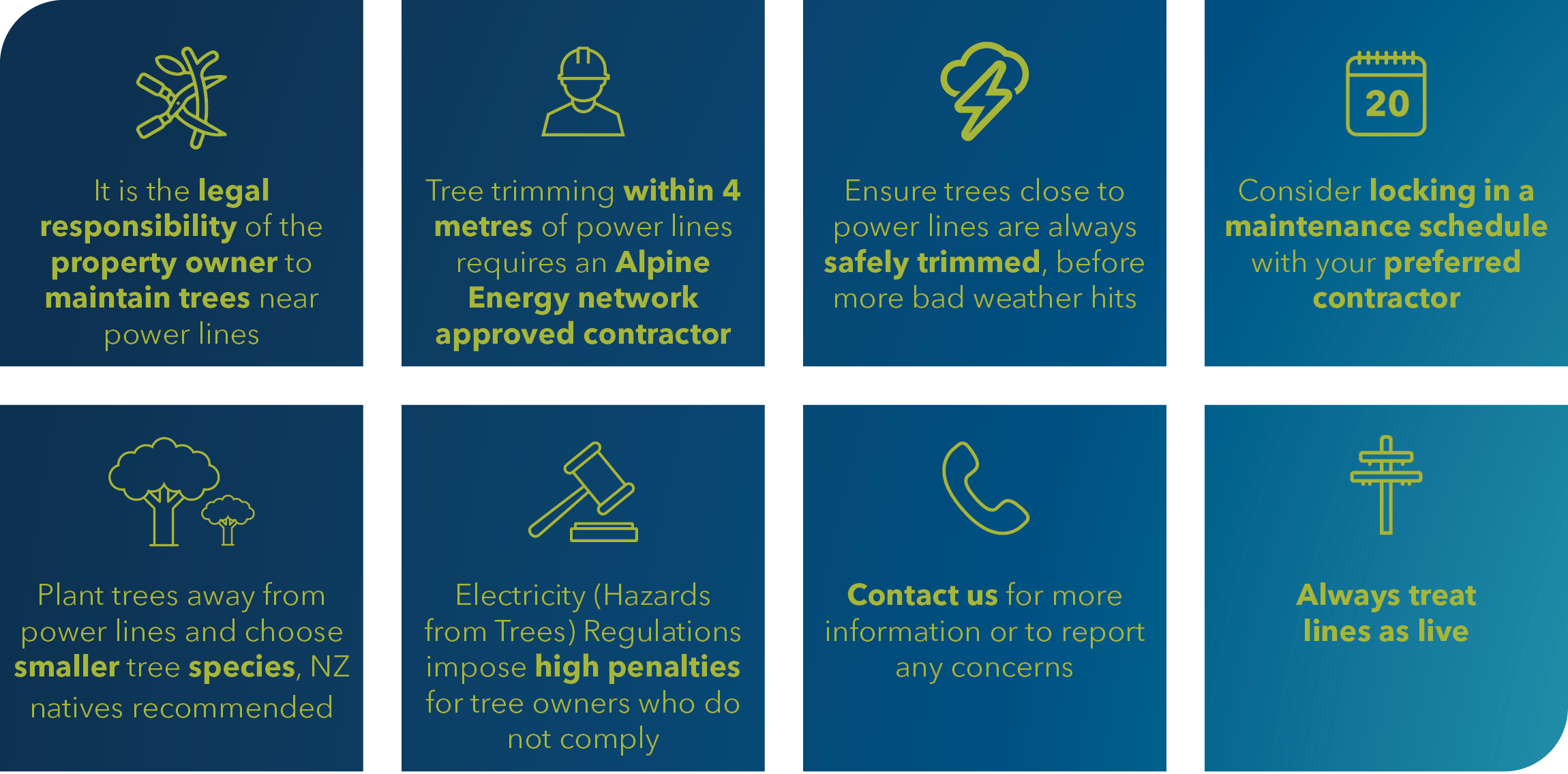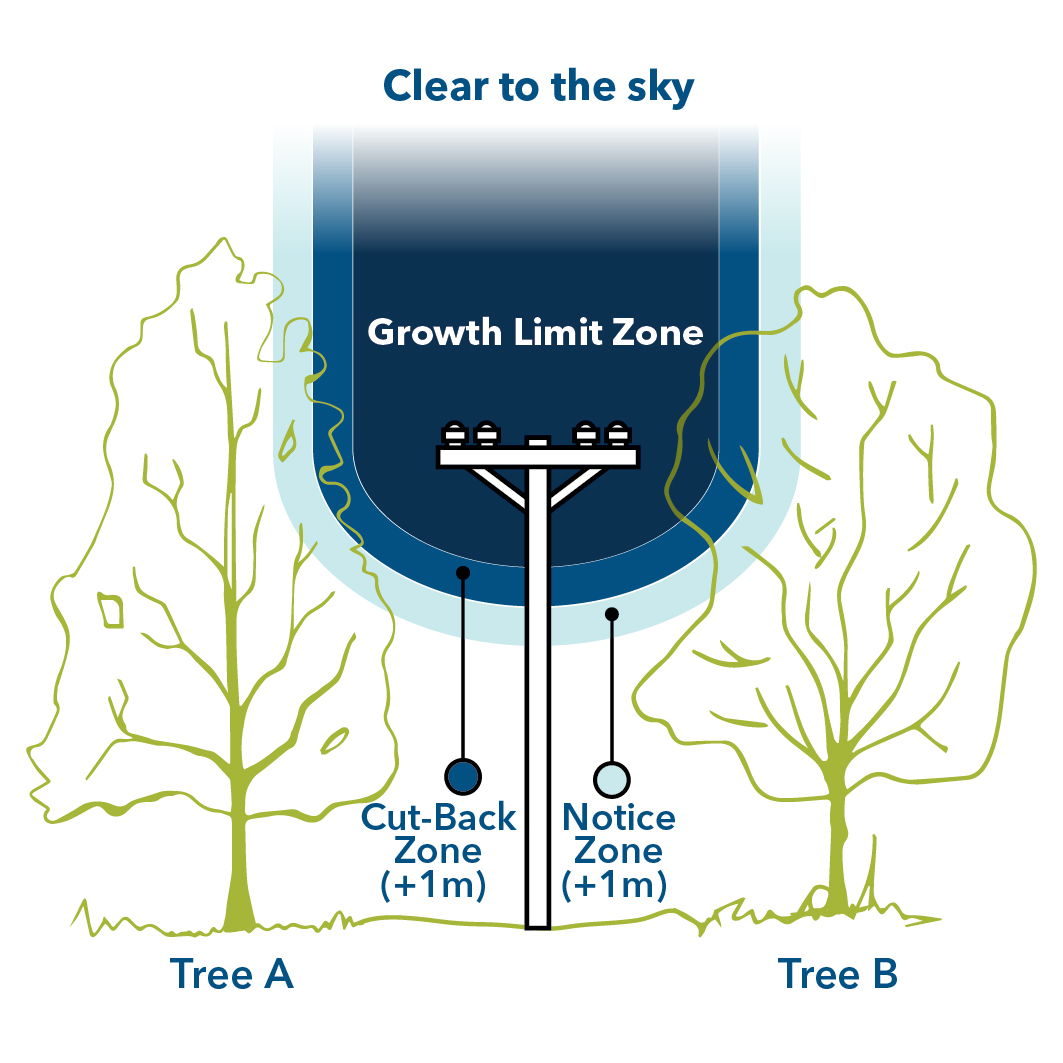Property owners and electricity distribution (lines) companies have a legal responsibility to ensure the safety and security of electricity supply for people, businesses, and communities.
Trees and vegetation growing too close to power lines are a key cause of unplanned power outages. That’s why the Electricity (Hazards from Trees) Regulations are important. It sets out what property owners and Alpine Energy are obligated to do to keep everyone safe.
Here’s what you need to know about your responsibilities.
The dangers of trees near power lines
If trees or branches come into contact with power lines it can cause damage, widespread outages, and create risk of serious injury or death.
As a property owner, you’re responsible for any trees on your property, and could be liable for the significant cost of any damage to power lines. That’s why it’s important to check trees or hedges regularly and take appropriate action if they do pose a risk. If you’re unsure what to do, contact us for advice.
Trees need to be kept at a safe distance from power equipment because:
- Children who climb trees close to power lines are at risk of serious injury or death.
- In severe weather, vegetation can become electrically ‘live’ and may pose an electrocution risk.
- Trees can fall during bad weather, snow or icy conditions, damaging power lines and causing outages.
- Trees close to power lines may cause electrical sparking, resulting in fire.
- Tree roots can grow around underground electricity cables, damaging the insulation and causing power supply failure.
Maintaining a safe distance
In October 2024, the Regulations were updated to increase the minimum safe distances between trees and power lines, and a new ‘clear to the sky’ requirement for some trees.
If your tree is growing within the Cut-back or Notice Zone (Tree A), you may get a legal notice saying your trees must be trimmed soon because they’re getting too close to power equipment.
Should they reach the Growth Limit Zone (Tree B), you will get a legal notice requiring them to be trimmed.
Cutting trees near power lines
Cutting trees near power lines can be dangerous and requires specialised skills.
Trimming trees within a 4-meter perimeter around power lines must be carried out by an Alpine Energy network approved contractor.
It’s important you take the necessary precautions to keep you and others safe.
Cut/Trim notices
We conduct regular surveys to check the network for trees and vegetation that pose a risk to power equipment. You’ll receive a notice for trimming if your trees need attention under the Regulations, and this will be by a specific date.
In most cases, if it’s your first Cut/Trim Notice we’ll pay for it (conditions apply).
You can declare no interest in your trees near our network. If your declaration of no interest is accepted, we wil cover all reasonable costs of trimming or felling the tree(s) and in most cases, the tree(s) will be removed at ground level.
Second cut/trim
After that you’re responsible for taking care of the trees on your property. This includes organising and paying for an Alpine Energy network approved contractor to trim them safely if they’re within 4-meters of power equipment.
Being proactive and inspecting your trees will help ensure the power can stay on for everyone.
Please note that if your trees cause any problems on the electricity network, you may be charged for all repair costs.
Fines
You can be fined up to $10,000 if you don’t comply with written requests to cut/trim your trees or don’t tell us the work is taking place. We need a minimum of 3 days’ notice.
You can also be fined an additional $500 for every day this doesn’t happen.
If your trees are deemed an immediate danger to the network, we’re obligated to remove the hazard. If you haven’t kept your trees clear of power lines or not returned the required paperwork, you’ll be responsible for all the costs we incur to remove the hazard.
For more information about trees near power lines please download our latest leaflet:
Apply to remove trees and vegetation near overhead power lines (PDF)
Government regulations
The Electricity (Hazards from Trees) Regulations have been in effect since July 1st 2003. The regulations set minimum distances trees must be kept away from power lines and methods of managing trees in the vicinity of power lines and electrical supply equipment. The purpose of these regulations is to protect the security of the electricity supply and the safety of the public.
Electricity (Hazards from Trees) Regulations 2003
Planting guide
There are a variety of shrubs and trees suitable for planting near power lines. Please click on the link below for a list of these trees or contact us to discuss other options.
Trees are the major cause of power outages in a storm.
Trees are an essential part of our environment, but they also pose a significant risk to our electricity network. Trees too close to power lines are a hazard and a major cause of power outages during bad weather. Overgrown trees also make it difficult for crews to restore power. As a responsible lines company, we are committed to ensuring the safety of our community and the reliability of our network.
Here are some TOP TIPS to prevent power outages and ensure the safe maintenance of trees near power lines:

As a community we share the responsibility of managing trees. Let’s work together to keep our community safe and keep the power flowing.
If you see a tree touching a power line or any other hazardous tree condition, please contact us immediately on 0800 66 11 77.
You can also take a photo of it and send the image and information to us using the free app Snap Send Solve.
Chat to us
We want to work with you to keep trees trimmed, power on and our community safe. If we haven’t met your expectations for any reason, please let us know so we can discuss it with you.
If we can’t resolve your concern, you can contact Utilities Disputes Limited – a free and independent resolution service. Visit www.udl.co.nz

